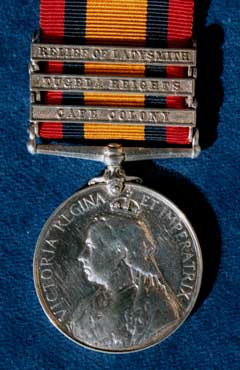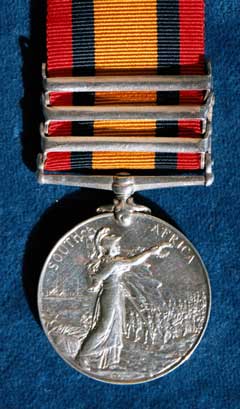MEDAL INFORMATION
Queen’s South Africa Medal
(11 Oct 1899-31 May 1902)
Face
The crowned and veiled
bust of Queen Victoria surrounded by the legend: “VICTORIA REGINA ET
IMPERATRIX”.
Reverse
The standing figure of
Britannia with a flag in her left hand, her right arm extended holding a
laurel wreath towards an advancing body of troops. Two warships are in
the background. Around the top are the words “SOUTH AFRICA”. There are
two different strikings of the medal, the first has the laurel wreath and
Britannia’s arm pointing to the ‘R’ in ‘Africa’ and below them the dates
“1899 - 1900”. These medals were issued in 1900 when it was thought that
the war was over. When the truth dawned, the remaining ‘first issue’
medals had the dates removed and on many of these the ‘ghost’ dates can
still be seen when held at an angle to the light. On the second striking
of the medal the dates were omitted and the wreath and Britannia’s arm
point to the ‘F’ of ‘Africa’.
Size & Composition
36mm in diameter, the
medal and bars are of silver.
Ribbon & Suspension
32 mm wide. Red
edges, each 6 mm wide, within which are two blue stripes each 4.5 mm wide
enclosing a central orange stripe approx. 11 mm wide. The ribbon passes
through a plain, straight, swivelling suspender. Sizes approximate.
Naming
Generally in indented
block capitals and giving Number, Rank, Initials, Surname and Unit. In
the case of The King’s Own the unit is shown as “R:LANC:REGT”, or
“RL:LANC:REGT” or for the Mounted Infantry: “R:LANC:REGT MI”.
Bars
Twenty six - the
maximum number to any one Army medal being nine and to the Royal Navy
eight. The bars are: CAPE COLONY; NATAL; RHODESIA; RELIEF OF MAFEKING;
DEFENCE OF KIMBERLEY; TALANA; ELANDSLAAGATE; DEFENCE OF LADYSMITH;
BELMONT; MODDER RIVER; TUGELA HEIGHTS; RELIEF OF KIMBERLEY; PAARDEBERG;
ORANGE FREE STATE; RELIEF OF LADYSMITH; DRIEFONTEIN; WEPENER; DEFENCE OF
MAFEKING; TRANSVAAL; JOHANNESBURG; LAINGS NEK; DIAMOND HILL; WITTEBERGEN;
BELFAST; SOUTH AFRICA 1901; SOUTH AFRICA 1902.
Awarded
To all who served in
South Africa during the Boer War 1899-1902. Of the twenty-six bars
awarded five were ‘state’ bars and two were ‘date’ bars for service
covering the many minor actions for which ‘battle’ bars were considered
inappropriate. The medal was also issued without a bar to troops guarding
Prisoners-of-War on St Helena, to certain Royal Navy personnel, nurses,
members of St John’s Ambulance Brigade and other civilians who were
closely concerned with the war effort. Bronze medals without bars were
also awarded to Indian and West Indian troops and local natives who
served.
The war comprised three
phases: firstly, the Boer advance into Natal and Cape Colony, the sieges
of Ladysmith, Kimberley and Mafeking and the British operations leading to
the relief of those towns, during which a number of pitched battles took
place; secondly, from February to July 1900 the British advance into the
Orange Free State and Transvaal when the Boer Republics were annexed; and
thirdly, from August 1900 to almost the end of 1902, when the guerrilla
warfare waged by the Boers was ultimately overcome by the use of the
Blockhouse system, ‘drives’ by bodies of mounted troops against the
guerrillas, and the destruction of crops and farms.
The
King’s Own
The 2nd Battalion The
King’s Own Royal Lancaster Regiment served in South Africa from December
1899 through to February 1903 and took part in major actions at Spion Kop,
Onderbrook Hill and Pieters Hill during the Relief of Ladysmith. On 11
December 1900 the Battalion successfully defended Lancaster Hill at
Vryheid against a determined attack by the Boers. During 1900-1901 the
Battalion was reinforced by two Active Service Companies from the 1st and
2nd (Volunteer) Battalions and also by drafts provided by the 1st
Battalion recently returned to England from Singapore. The 3rd and 4th
(Militia) Battalions both saw active service in South Africa, and the 1st
Battalion provided about 450 officers and men who served in five Mounted
Infantry Battalions from February 1901 to December 1902.
Queen's
South Africa Medals in the museum's collection


Queen's South Africa Medal



